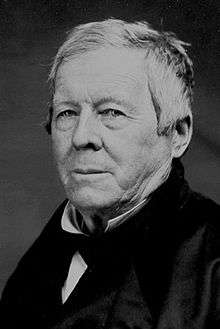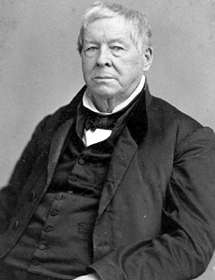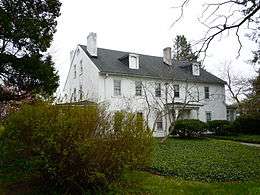Thomas Garrett

Thomas Garrett (August 21, 1789 – January 25, 1871) was an American abolitionist and leader in the Underground Railroad movement before the American Civil War.
Early life
Garrett was born into a prosperous landowning Quaker family on their homestead called "Riverview Farm" in Delaware County, Pennsylvania. When Thomas was a boy, one of the family's free black female servants was kidnapped by men who intended to sell her into slavery in the South. The Garrets rescued her, but this incident confirmed them in their abolitionist views, and all the sons would later become involved in abolitionism, and Thomas on a very large scale.
When their father died in 1839, the original farm was split between Thomas' brothers' Issac and Edward, who renamed their farms "Fernleaf Farm" and "Cleveland Farm", but much is preserved today as Arlington Cemetery.[1] Thomas's house, "Thornfield" built around 1800 and in which he lived until 1822, still stands today (as a private residence) in what is now Drexel Hill in Upper Darby Township.
Career

In the schism between Orthodox and Hicksite Quakers, Garrett split with his Orthodox family and moved to Wilmington in the neighboring slave state of Delaware to strike out on his own and pursue his struggle against slavery. He established an iron and hardware business and made it prosper.
In 1827 Society of the State of Delaware was reorganized as the Delaware Abolition Society, whose officers and directors included Garrett, William Chandler, president John Wales, vice-president Edward Worrell, and others. Later that year, Wales and Garrett represented the group at the National Convention of Abolitionists.[2]
In 1835, Garrett became a director of the new Wilmington Gas Company, which made gas "made from rosin, at $7 per 1,000 cubic feet" for lighting lamps.[3] In 1836, he, Chandler, Joseph Whitaker, and other partners invested and revived the Principio Furnace in Perryville, Maryland, near an important crossing of the Susquehanna River at the top of Chesapeake Bay.[4]
Garrett openly worked as a stationmaster on the Underground Railroad in Delaware, working with William Still in Philadelphia and John Hunn further down the Delmarva Peninsula. Because he openly defied slave hunters as well as the slave system, Garrett had no need of secret rooms in his house at 227 Shipley Street. The authorities were aware of his activities, but he was never arrested.
In 1848, however, he and fellow Quaker John Hunn were sued in federal court for helping a family of eight slaves owned by two owners escape, although their lawyer colleague John Wales had managed to free them from imprisonment the previous year when a magistrate granted a writ of habeas corpus. However, the two slaveowners sued Hunn and Garrett. U.S. Supreme Court Chief Justice Roger B. Taney presided at the trial in the New Castle Court House, and James A. Bayard, Jr. acted as prosecutor. Garrett and Hunn were found guilty of violating the Fugitive Slave Act by helping a family of slaves escape.[5] As the "architect" of the escape, Garrett received a $4,500 fine, later reduced to $1500.[6] According to Kathleen Lonsdale, referencing the American Friends Service Committee, "The fine was so heavy that it left him financially ruined, yet Thomas Garrett stood up in Court and said Judge thou has left me not a dollar, but I wish to say to thee and to all in this courtroom that if anyone knows a fugitive who wants a shelter and a friend, send him to Thomas Garrett and he will befriend him." [7] A lien was put on his house until the fine was paid, and although Hunn ended up losing his house in a sheriff's sale, with the aid of friends Garrett continued in his iron and hardware business and helping runaway slaves to freedom. By 1855, traffic through Garrett's station had increased, and Sydney Howard Gay noted that in 1855-1856 nearly 50 fugitives whom Garrett had helped arrived in New York.[8]
William Lloyd Garrison, whom Garrett admired greatly, once visited him. However, they held different views regarding the opposition to slavery. Garrison was willing to be a martyr to the abolition of slavery and would not defend himself if attacked physically. Garrett, on the other hand, believed slavery could only be abolished through a civil war and, when attacked physically, defended himself by subduing his attackers.
Garrett was also a friend and benefactor to the noted Underground Railroad Conductor Harriet Tubman, who passed through his station many times.[9] In addition to lodging and meals, Garrett frequently provided her with money and shoes to continue her missions conducting runaways from slavery to freedom. Garrett also provided Tubman with the money and the means for her parents to escape from the South. (Both were free people at the time Tubman rescued them, but Tubman's father faced arrest for secreting runaway slaves in his cabin.)

The number of runaways Garrett assisted has sometimes been exaggerated. He said he "only helped 2,700" before the Civil War put an end to slavery.
During the American Civil War, the free Negroes of Wilmington guarded Garrett's house. When the 15th Amendment passed, giving Negro males the right to vote, Wilmington's African Americans carried Garrett through the streets in an open barouche with a sign: "Our Moses."
Death and legacy
Garrett died on January 25, 1871, at the age of 81. Freed blacks carried his bier on their shoulders to the Quaker Meeting House on West 4th Street in Wilmington, where he was interred.
In 1993, Wilmington named Tubman-Garrett Riverfront Park after the two Underground Railroad agents and friends.[10] Pennsylvania and Delaware have also erected historical markers at sites associated with Garrett, in Drexel Hill[11] and Wilmington, respectively.[12] His house, Thornfield, remains private property near the historic marker on Garrett Road in Upper Darby.[13]
See also
References
- ↑ Underground Railroad Map. Network to Freedom, National Park Service.
- ↑ Scharf, John Thomas (1888). History of Delaware : 1609-1888. L.J. Richards. Retrieved November 27, 2013.
- ↑ "Items of Interest from Various Localities". The American Gas Light Journal. 75. July–December 1901.
- ↑ Historical Society of Cecil County, "Principio", Milt Diggins Archived August 12, 2011, at the Wayback Machine.
- ↑ "National Historic Landmark Nomination" (PDF). National Park Service. Retrieved January 6, 2015.
- ↑ Bertice Berry, The Ties that Bind: a memoir of race, memory and redemption (New York: Broadway Books, 2009), pp. 96–102.
- ↑ Kathleen Lonsdale, Is Peace Possible?, Penguin Books, 1957, p. 124 (referring to Speak Truth to Power by the AFSC).
- ↑ Eric Foner, Gateway to Freedom: the Hidden History of the Underground Railroad (W.W. Norton & Co., 2015), pp. 155–58.
- ↑ Foner, p. 192.
- ↑ "Thomas Garrett", Harriet Tubman.com.
- ↑ "Thomas Garrett | Stationmaster on the Underground Railroad", HMdb.
- ↑ "Thomas Garrett Stationmaster on the Underground Railroad (NC-88)" - Delaware Historical Markers on Waymarking.com.
- ↑ "Saving the Lower Swedish Cabin", Historically Speaking (Publication of the Upper Darby Historical Society), Winter 2008, Vol. 23, No. 2.
- James A. McGowan, Station Master of the Underground Railroad, the Life and Letters of Thoma Garrett, Jefferson, NC.: McFarland & Co., 2005.
- Claus Bernet (2010). "Thomas Garrett". In Bautz, Traugott. Biographisch-Bibliographisches Kirchenlexikon (BBKL) (in German). 31. Nordhausen: Bautz. cols. 484–486. ISBN 978-3-88309-544-8.
- Mariah Parker, Thomas Garrett, Quakers and Slavery, accessed April 17, 2011.
External links
| Wikimedia Commons has media related to Thomas Garrett. |
| Wikiquote has quotations related to: Thomas Garrett |
